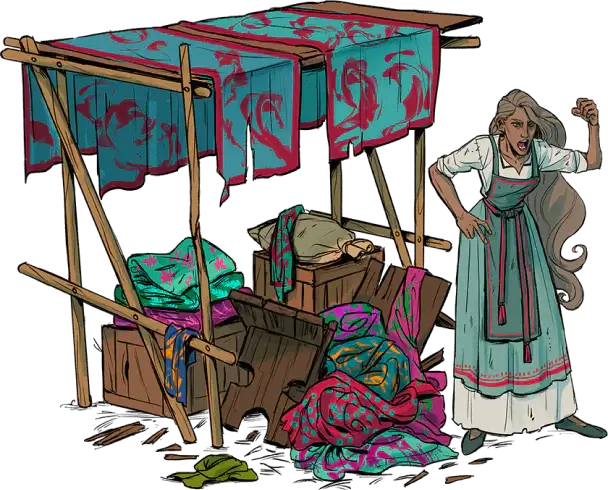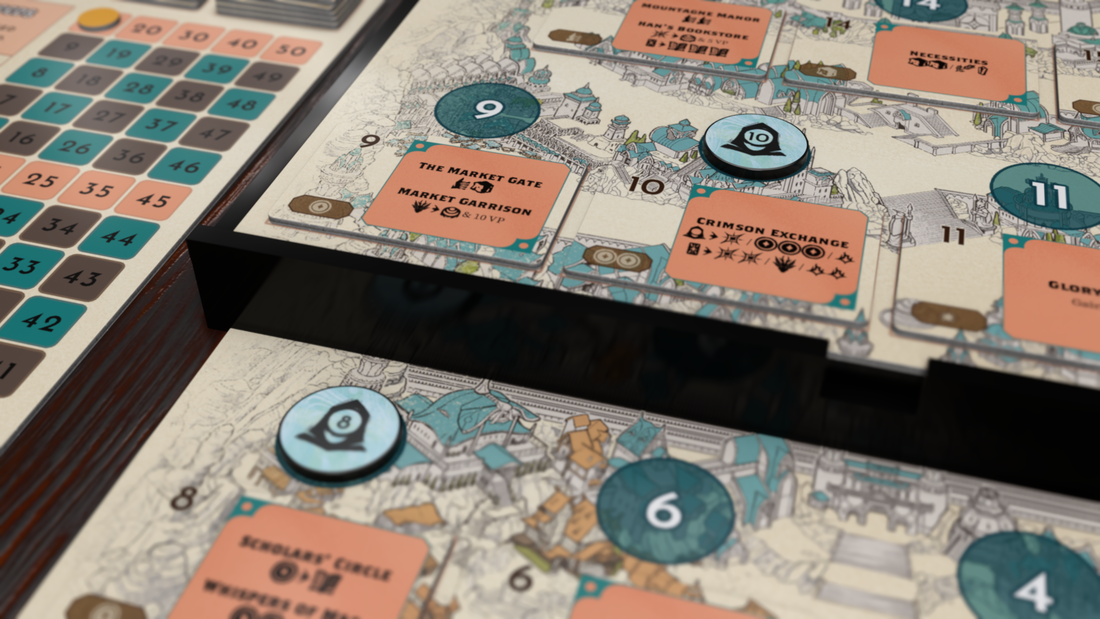Kinfire Council Design Diary #2
You Haul 16 Cubes, and What Do You Get?
Check Out the Kickstarter: https://www.kickstarter.com/projects/ahj00ma/kinfire2024
Hello again! I’ve been hard at work playtesting the game, and it’s coming together quite nicely! I’m still tweaking little details here and there, maybe a player power or two, but by and large, Kinfire Council is feeling pretty good and should be in shape for the kickstarter at the end of April! So, let’s pick up from last time and talk about the second main aspect I focused on in the design - Labor.
In this case, ‘labor’ meant to me that the players, as the leaders of the city of Din’Lux, would be bossing around other people to do their bidding, and I had the fun idea that they’d also be bossing around the characters from Kinfire Chronicles and Kinfire Delve - the Seekers.
I almost immediately decided that I wanted to use a worker placement framework for the design, as it fit really well with the narrative and wouldn’t need much explanation to most of the audience. Then, I could take that framework and twist it to my needs. Also, we already had a terrific city map to work with of Din’Lux, and a number of interesting places in the city that I could work into the game.:strip_icc()/pic8116063.jpg)
:strip_icc()/pic8116065.jpg)
:strip_icc()/pic8116067.jpg)
Taxation
The first big concept I wanted to incorporate into the game was that Din’Lux is divided into several boroughs that are economically segregated. The Stumps and the Horseshoe are the poorer districts, the Nests are the middle class/merchant district, and the Coping is the noble/ruling district. In the city, as often is the case in real life, the higher you go, the more expensive and exclusive that part of town becomes. This translates into 3 “tiers” of Din’Lux. Sending workers to the lowest tier is free, but sending workers to a higher tier requires the player to pay a tax to the city coffers of 1 or 2 coins, depending on tier. In my head, from the very beginning, I’ve been planning to use the storage trays in the game to lift up the higher tiers of the city physically as a visual reminder of the mechanic. My fingers are still crossed that we can pull that off.
Now, this tiered taxation system serves a number of purposes in the design beyond just theming, however. It provides meaningful context to each player’s turn, gives you information that you can use to predict your opponents’ moves, and creates a little pool of semi-neutral cash that I’ve been able to do a lot of interesting things with in the game, sort of how taxes form a city’s budget in real life. Sometimes you can pass laws to let you do interesting things with the money in the city’s coffers, but if you don’t use it, half of it will drain away each round as “government waste” (and if someone is playing Hierophant Selen, they get to take that government waste as “alms for the church”, which really incentivizes them to keep everyone else’s grubby little hands off of “their” money).:strip_icc()/pic8116070.jpg)
Upgrading Locations
The other big thing I wanted to represent in the game is the ongoing struggle of the Council to rebuild and improve the city of Din’Lux. The city is overcrowded and damaged thanks to the return of the Starless Nights and the events that took place at the end of Kinfire Chronicles: Night’s Fall, so the councilors are encouraged to work to upgrade the various locations around town. Doing so gains them some VPs and flips the location tile over to its upgraded side and lets the player mark it with an influence token, becoming that location’s “patron”. If you become the patron of a location, each time someone else uses it, you’ll receive a small “patron’s bonus”, which is often a coin or other useful resource. If you’re careful how you do this, you can manage a tidy little passive income from your patronages, or you can just scare your opponents away from valuable locations that you want to use yourself.:strip_icc()/pic8116072.jpg)
Worker Skills and Seekers
As I mentioned before, I wanted the Seekers to show up in the game as some of the players’ workers, and this gave me a couple of interesting opportunities. At first, I decided that I wanted each Seeker to have a unique skill that would affect how they behave as a worker, and later I decided to open these skills up to all of the workers in the game. Ultimately, I created a set of 6 skills that workers can be taught to give them special abilities. One example is the Artisan skill, which lets that worker claim the patron bonus from the space they’re played in as long as that space doesn’t already have a patron. Another example is the Merchant skill, which lets that worker be played anywhere in the city without paying taxes. Each worker can only learn one skill at a time, but you can change your mind later and teach a worker a different skill. I wanted this mechanic to allow players to really dig into trying different strategies and to allow counterplay against strategies (Selen is too rich? Well, stop paying taxes…)
As for the Seekers, they start the game knowing one of the 6 skills by default, but can’t be taught a different skill. They can, however, leave the city to visit a nearby village or to confront a threat looming outside the walls, so they still have a lot of importance for the players. In addition, during setup, the Councilors are randomly paired up with one Seeker each, and then the players take turns choosing which combo of Councilor and Seeker they want to play. This means that you aren’t always going to see the same combinations drafted game after game, and actually provides 720 unique player power setups at the start of the game, if my math is right./pic8116075.jpg)
/pic8116076.jpg)
City Needs
Last but not least, I wanted the players to have to deal with the growing and ever changing demands of the citizens of Din’Lux. This is represented by the City Needs track, which starts with 3 Supply resources on it. Each round, the players must provide these resources to the city, or else the Cult of Altan gains followers and power. Meeting City Needs can provide a small but steady income of VPs (1 per Need met) for not too much effort, but you can also recruit Sentries which increase the value of City Needs for you, letting you potentially create a hugely powerful scoring engine, assuming the other players just let you do it, of course.
And if you remember those influence tokens we’ve talked about…to meet a City Need, you have to mark it with one of your influence tokens. That’s influence you can’t use for voting on decrees or marking your patronages, etc. Sometimes City Needs go unmet because the Councilors are just plain too busy to get around to them.
The City Needs also grow and ebb over the course of the game. Decrees that represent the city spending large sums of money often add to the City Needs track. Building a lighthouse, on the other hand, lets a player permanently meet a City Need, collecting the VP for it every turn from then on, at the cost of tying up one of their influence tokens.
Overall, I took a lot of inspiration from how real cities operate - collecting taxes, passing city legislation, and balancing spending with the needs of the inhabitants - but looking at it through the lens of our fantasy city, Din’Lux, and with a priority of making the gameplay fun and varied.
Anyway, that was a lot to talk about, so I’ll rope it off here, and next time we’ll talk about the last of the three main aspects of the game - Threats.



